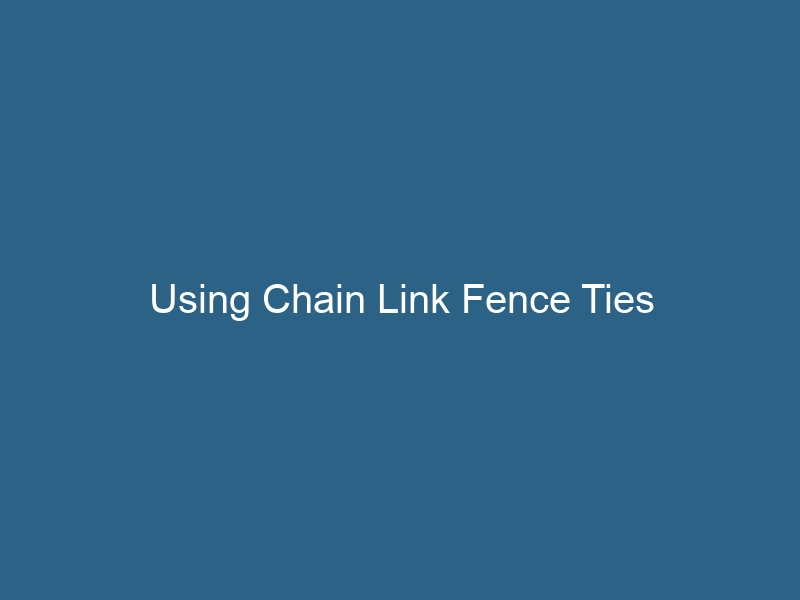Quck answer
Chain link fence ties are essential for securing and connecting chain link fence fabric to the framework. To use chain link fence ties, follow these steps:
1. Start by laying out the chain link fence fabric along the fence line.
2. Attach the end of the fabric to the corner or end post using a tension bar and tension bands.
3. Insert a fence tie through the first hole in the fabric and wrap it around the post.
4. Twist the tie tightly using pliers or a fence tool to secure the fabric to the post.
5. Continue attaching the fabric to the posts every few feet using fence ties.
6. Make sure to tighten the fabric using a fence stretcher if needed.
7. Repeat the process for all remaining sections of the chain link fence.
By using chain link fence ties correctly, you can ensure a secure and durable fence installation.
Despite lacking in appearance, chain link fencing is highly useful, affordable, and easy to maintain. This type of fencing is popular due to its ease of upkeep and repair.

Image Credit:
Sergii Kateryniuk/iStock/GettyImages
A good chain link fence is made up of metal posts set in concrete, with a spacing of 6 to 10 feet between them. The closer the posts are set, the more sturdy the fencing will be, but costs will also increase.
Fortunately, chain link ties, which are wires or bands used to attach the chain link fabric to the posts and rails, make maintenance affordable and simple. With low per-tie costs, conducting seasonal repairs to keep your fencing in good condition is easy.
Factors to Consider when Purchasing
All chain link wires and ties are not equal. The “gauge” measures the strength of the metal in a chain link tie, with lower numbers indicating greater strength or heaviness. For residential yard fencing, 11- to 9-gauge ties are sufficient. For commercial and high-security purposes, 9- to 6-gauge ties are recommended, although they will be more expensive.
There is also a pricing difference between preformed wires, bands, and ties compared to traditional ties. Preformed options are easier to attach and tend to be more secure as they are less likely to be improperly affixed. If you choose preformed ties, there are various types available, each with installation instructions included in the packaging.
The Two Most Common Styles
Twist ties are commonly used in commercial installations and correctional institutions. They come pre-shaped for easy wrapping around the post and can be quickly twisted into place using a custom drill bit for power tools, making installation faster. These drill-tied styles ensure the chain link fabric is tightly secured, reducing vibrations that can trigger commercial security alarms.
Self-locking fabric bands are not ties, but rather bands that wrap around the fence post or rail, securing a portion of the chain link wire. One end of the band is longer and folds over the shorter end, similar to an envelope tab. Linesman’s pliers can be used to pinch the two parts of the band together, and then fold them over again so that they lie flat against the post or rail. These bands are visually appealing and durable enough for residential use.
Installing Traditional Chain Link Ties
If you are using traditional ties, sometimes referred to as J-hooks due to their shape, it requires a bit more effort compared to bands or preformed ties. Simply put, the ties are wrapped around the post so that both ends come out on opposite sides, passing through the chain link fabric. Pliers are then used to fold the tie around one wire of the chain link fabric. This process is repeated for the other end of the tie, folding it around another wire in the fabric. This should be done for each tie.
The tighter the tie is wrapped and folded over, the more secure and taut the chain link fabric will be.
In a typical installation, it is recommended to have tie spacing every 18 to 24 inches along the fencing and up the fence posts. However, it is better to have 18 inches between each tie, as this will keep the chain link fabric well-supported in the long run. Despite the cost of a few cents per tie or band, it is worth spending more time to securely attach the fabric at intervals of 1 foot. For vertical posts, it is advisable to use at least one tie every foot.
We have all witnessed the droopy and loose chain link fence, which is the result of using too few ties during the installation process.
If you have a dog that jumps on the fence whenever the mail truck passes by or a child who dreams of playing soccer professionally and practices rebounding against the fence with their ball, you will appreciate using more ties.


